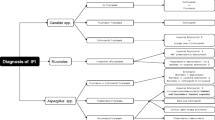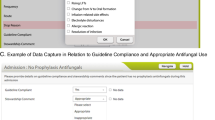Abstract
Invasive fungal infection (IFI) is an important cause of morbidity and mortality in patients with hematologic malignancy, prolonged neutropenia, or after hematopoietic stem cell transplant. Antifungal prophylaxis prevents IFI in high-risk hematology patients. This article discusses recent developments in antifungal prophylaxis, focusing on those expected to affect patient management. Significant advances have occurred in understanding risk stratification and assessment of individual patient risk for drug-drug interactions, toxicity, or variations in pharmacokinetics; choice of antifungal prophylaxis strategy, drug, dose, route, and regimen; therapeutic drug monitoring; cost effectiveness of prophylaxis; and the significance of breakthrough IFI. Research over the coming decade is likely to fundamentally alter antifungal prophylaxis by allowing clinicians to make individualized decisions for their patients informed by rapid, detailed, and personalized risk-benefit analyses.
Similar content being viewed by others
References and Recommended Reading
Goodman JL, Winston DJ, Greenfield RA, et al.: A controlled trial of fluconazole to prevent fungal infections in patients undergoing bone marrow transplantation. N Engl J Med 1992, 326:845–851.
Slavin MA, Osborne B, Adams R, et al.: Efficacy and safety of fluconazole prophylaxis for fungal infections after marrow transplantation—a prospective, randomized, double-blind study. J Infect Dis 1995, 171:1545–1552.
Marr KA, Carter RA, Boeckh M, et al.: Invasive aspergillosis in allogeneic stem cell transplant recipients: changes in epidemiology and risk factors. Blood 2002, 100:4358–4366.
Slavin MA, Heath CH, Thursky KA, et al.: Antifungal prophylaxis in adult stem cell transplantation and haematological malignancy. Intern Med J 2008, 38:468–476.
Upton A, Kirby KA, Carpenter P, et al.: Invasive aspergillosis following hematopoietic cell transplantation: outcomes and prognostic factors associated with mortality. Clin Infect Dis 2007, 44:531–540.
Perfect JR: Antifungal prophylaxis: to prevent or not. Am J Med 1993, 94:233–234.
Prentice HG, Kibbler CC, Prentice AG: Towards a targeted, risk-based, antifungal strategy in neutropenic patients. Br J Haematol 2000, 110:273–284.
Kontoyiannis DP, Chamilos G, Lewis RE, et al.: Increased bone marrow iron stores is an independent risk factor for invasive aspergillosis in patients with high-risk hematologic malignancies and recipients of allogeneic hematopoietic stem cell transplantation. Cancer 2007, 110:1303–1306.
Garcia-Vidal C, Upton A, Kirby KA, Marr KA: Epidemiology of invasive mold infections in allogeneic stem cell transplant recipients: biological risk factors for infection according to time after transplantation. Clin Infect Dis 2008, 47:1041–1050.
Bochud PY, Chien JW, Marr KA, et al.: Toll-like receptor 4 polymorphisms and aspergillosis in stem-cell transplantation. N Engl J Med 2008, 359:1766–1777.
Zaas AK, Liao G, Chien JW, et al.: Plasminogen alleles influence susceptibility to invasive aspergillosis. PLoS Genet 2008, 4:e1000101.
Neth OW, Bacher U, Das P, et al.: Influence of mannosebinding lectin genotypes and serostatus in Allo-SCT: analysis of 131 recipients and donors. Bone Marrow Transplant 2009 (Epub ahead of print).
Rubnitz JE, Howard SC, Willis J, et al.: Baseline mannose binding lectin levels may not predict infection among children with leukemia. Pediatr Blood Cancer 2008, 50:866–868.
Cordonnier C, Pautas C, Maury S, et al.: Empirical versus preemptive antifungal therapy for high-risk, febrile, neutropenic patients: a randomized, controlled trial. Clin Infect Dis 2009, 48:1042–1051.
Marr KA, Balajee SA, McLaughlin L, et al.: Detection of galactomannan antigenemia by enzyme immunoassay for the diagnosis of invasive aspergillosis: variables that affect performance. J Infect Dis 2004, 190:641–649.
Worth LJ, Blyth CC, Booth DL, et al.: Optimizing antifungal drug dosing and monitoring to avoid toxicity and improve outcomes in patients with hematological disorders. Intern Med J 2008, 38:521–537.
Krishna G, AbuTarif M, Xuan F, et al.: Pharmacokinetics of oral posaconazole in neutropenic patients receiving chemotherapy for acute myelogenous leukemia or myelodysplastic syndrome. Pharmacotherapy 2008, 28:1223–1232.
Sansone-Parsons A, Krishna G, Simon J, et al.: Effects of age, gender, and race/ethnicity on the pharmacokinetics of posaconazole in healthy volunteers. Antimicrob Agents Chemother 2007, 51:495–502.
Wang G, Lei HP, Li Z, et al.: The CYP2C19 ultra-rapid metabolizer genotype influences the pharmacokinetics of voriconazole in healthy male volunteers. Eur J Clin Pharmacol 2009, 65:281–285.
Weiss J, Ten Hoevel MM, Burhenne J, et al.: CYP2C19 genotype is a major factor contributing to the highly variable pharmacokinetics of voriconazole. J Clin Pharmacol 2009, 49:196–204.
Sim SC, Risinger C, Dahl ML, et al.: A common novel CYP2C19 gene variant causes ultrarapid drug metabolism relevant for the drug response to proton pump inhibitors and antidepressants. Clin Pharmacol Ther 2006, 79:103–113.
Ragia G, Arvanitidis KI, Tavridou A, Manolopoulos VG: Need for reassessment of reported CYP2C19 allele frequencies in various populations in view of CYP2C19*17 discovery: the case of Greece. Pharmacogenomics 2009, 10:43–49.
Sugimoto K, Uno T, Yamazaki H, Tateishi T: Limited frequency of the CYP2C19*17 allele and its minor role in a Japanese population. Br J Clin Pharmacol 2008, 65:437–439.
Lehrnbecher T, Laws HJ, Boehm A, et al.: Compliance with anti-infective preventive measures: a multicentre survey among paediatric oncology patients. Eur J Cancer 2008, 44:1861–1865.
Potoski BA, Sima AP: Effect of intravenous voriconazole (IVV) on serum creatinine in a population of patients with stable renal dysfunction. Presented at 48th ICAAC/IDSA 46th Annual Meeting. Washington, DC; October 25–28, 2008.
Harnicar S, Adel N, Jurcic J: Modification of vincristine dosing during concomitant azole therapy in adult acute lymphoblastic leukemia patients. J Oncol Pharm Pract 2009, 15:175–182.
Bruggemann RJ, Touw DJ, Aarnoutse RE, et al.: International interlaboratory proficiency testing program for measurement of azole antifungal plasma concentrations. Antimicrob Agents Chemother 2009, 53:303–305.
Trifilio SM, Yarnold PR, Scheetz MH, et al.: Serial plasma voriconazole concentrations after allogeneic hematopoietic stem cell transplantation. Antimicrob Agents Chemother 2009, 53:1793–1796.
Cordonnier C, Mohty M, Faucher C, et al.: Safety of a weekly high dose of liposomal amphotericin B for prophylaxis of invasive fungal infection in immunocompromised patients: PROPHYSOME Study. Int J Antimicrob Agents 2008, 31:135–141.
El-Cheikh J, Faucher C, Furst S, et al.: High-dose weekly liposomal amphotericin B antifungal prophylaxis following reduced-intensity conditioning allogeneic stem cell transplantation. Bone Marrow Transplant 2007, 39:301–306.
Roman E, Osunkwo I, Militano O, et al.: Liposomal amphotericin B prophylaxis of invasive mold infections in children post allogeneic stem cell transplantation. Pediatr Blood Cancer 2008, 50:325–330.
Erjavec Z, Woolthuis GM, de Vries-Hospers HG, et al.: Tolerance and efficacy of Amphotericin B inhalations for prevention of invasive pulmonary aspergillosis in haematological patients. Eur J Clin Microbiol Infect Dis 1997, 16:364–368.
Rijnders BJ, Cornelissen JJ, Slobbe L, et al.: Aerosolized liposomal amphotericin B for the prevention of invasive pulmonary aspergillosis during prolonged neutropenia: a randomized, placebo-controlled trial. Clin Infect Dis 2008, 46:1401–1408.
Collins CD, Ellis JJ, Kaul DR: Comparative cost-effectiveness of posaconazole versus fluconazole or itraconazole prophylaxis in patients with prolonged neutropenia. Am J Health Syst Pharm 2008, 65:2237–2243.
Stam WB, O’sullivan AK, Rijnders B, et al.: Economic evaluation of posaconazole vs. standard azole prophylaxis in high risk neutropenic patients in the Netherlands. Eur J Haematol 2008, 81:467–474.
Cornely OA, Maertens J, Winston DJ, et al.: Posaconazole vs. fluconazole or itraconazole prophylaxis in patients with neutropenia. N Engl J Med 2007, 356:348–359.
Ullmann AJ, Lipton JH, Vesole DH, et al.: Posaconazole or fluconazole for prophylaxis in severe graft-versus-host disease. N Engl J Med 2007, 356:335–347.
Ananda-Rajah MR, Grigg A, Slavin MA: Breakthrough disseminated Scedosporium prolificans infection in a patient with relapsed leukaemia on prolonged voriconazole followed by posaconazole prophylaxis. Mycopathologia 2008, 166:83–86.
Schlemmer F, Lagrange-Xelot M, Lacroix C, et al.: Breakthrough Rhizopus infection on posaconazole prophylaxis following allogeneic stem cell transplantation. Bone Marrow Transplant 2008, 42:551–552.
Ustun C, DeRemer DL, Steele JC Jr, et al.: Fatal Aspergillus fumigatus and Candida glabrata infections with posaconazole prophylaxis after stem cell transplantation. Int J Antimicrob Agents 2008, 32:365–366.
Kishel JJ, Sivik J: Breakthrough invasive fungal infection in an immunocompromised host while on posaconazole prophylaxis: an omission in patient counseling and follow-up. J Oncol Pharm Pract 2008, 14:189–193.
Kaul DR, Lowe L, Visvesvara GS, et al.: Acanthamoeba infection in a patient with chronic graft-versus-host disease occurring during treatment with voriconazole. Transpl Infect Dis 2008, 10:437–441.
Madureira A, Bergeron A, Lacroix C, et al.: Breakthrough invasive aspergillosis in allogeneic haematopoietic stem cell transplant recipients treated with caspofungin. Int J Antimicrob Agents 2007, 30:551–554.
Trifilio S, Singhal S, Williams S, et al.: Breakthrough fungal infections after allogeneic hematopoietic stem cell transplantation in patients on prophylactic voriconazole. Bone Marrow Transplant 2007, 40:451–456.
Kersun LS, Reilly AF, Ingram ME, et al.: Antifungal susceptibility against yeasts isolated from pediatric oncology patients. Med Mycol 2008, 46:337–343.
Garcia-Effron G, Kontoyiannis DP, Lewis RE, Perlin DS: Caspofungin-resistant Candida tropicalis strains causing breakthrough fungemia in patients at high risk for hematologic malignancies. Antimicrob Agents Chemother 2008, 52:4181–4183.
Lamaris GA, Ben-Ami R, Lewis RE, Kontoyiannis DP: Does pre-exposure of Aspergillus fumigatus to voriconazole or posaconazole in vitro affect its virulence and the in vivo activity of subsequent posaconazole or voriconazole, respectively? A study in a fly model of aspergillosis. J Antimicrob Chemother 2008, 62:539–542.
Author information
Authors and Affiliations
Corresponding author
Rights and permissions
About this article
Cite this article
Wolf, J., Slavin, M.A. Risk-based antifungal prophylaxis in hematologic malignancy and stem cell transplantation. Curr Infect Dis Rep 11, 420–426 (2009). https://doi.org/10.1007/s11908-009-0061-z
Published:
Issue Date:
DOI: https://doi.org/10.1007/s11908-009-0061-z




